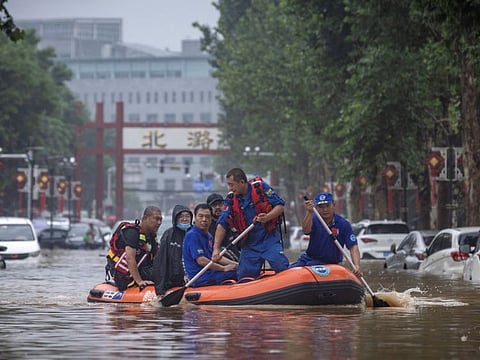China says 20 died in floods as storms sweep north
Xi calls for ‘every effort’ to rescue those ‘lost or trapped’ in flood waters

Beijing: Parts of northern China are grappling with the impact of intense flooding as the death toll rose to 20 following days of torrential rain in the wake of Typhoon Doksuri.
Remnants of the storm have inundated areas including Beijing, Tianjin and Hebei province since Saturday evening, causing widespread damage and forcing the evacuation of nearly a million people.
President Xi Jinping on Tuesday called for “every effort” to rescue those “lost or trapped”, state media reported.
“Xi Jinping demanded that all localities should make every effort to search for and rescue lost and trapped persons,” state broadcaster CCTV reported, adding they “must do a good job in treating the injured and comforting the families of victims, and minimise casualties.”
At least one district in the capital saw record rainfall, and Beijing authorities reported 11 fatalities, with more still missing. Hebei said 9 people died there.
One suburban area in Beijing appeared to be particularly hard hit. Mentougou, a hilly and partly rural district to the west, saw a record of nearly 70 centimeters (28 inches) of rainfall in two and half days, more than double what the rest of the city averaged during the deluge.
The disruptions from extreme weather add another headwind to China’s faltering economic recovery. The Caixin manufacturing purchasing managers index for July slid below the key 50 level that marks a contraction, adding to signs that a turnaround is not imminent. Central government ministries on Tuesday allocated 110 million yuan to support relief work in disaster-stricken areas, CCTV reported.
Impact
The impact on financial markets from flooding “is likely to be limited,” said Tommy Xie, an economist at Oversea-Chinese Banking Corp. in Singapore. “Nevertheless, if we look at this together with the July PMI data, the extreme weather will have a negative impact on economic activities.”
There were signs of the situation easing on Tuesday, with Beijing lowering its rainfall alert for most districts to the second-lowest in its four-tier emergency system. Mentougou remained at the second-highest.
Earlier, Beijing authorities had evacuated some 127,000 residents, state media reported. Scenic areas and some subway and bus lines were shuttered. Hebei said more than 840,000 people were evacuated.
Authorities have dispatched aid, personnel and food supply to flood-hit districts. Almost 2,000 passengers on two trains stranded earlier have been taken to safety. Another train carrying 800 passengers remains stuck near western Beijing.
Officials also announced plans to release some water from the Hai River to parts of Hebei and Tianjin to slow the rapidly increasing flow. The water release starts early Tuesday to Hebei areas and is expected to reach Tianjin around Aug. 9, according to local newspaper Tianjin Daily.
Doksuri is one of the strongest typhoons to hit China this year. It landed in the southeastern province of Fujian on Friday, forcing local authorities to close schools and suspend public transport. Power lines were disrupted and the weather bureau reported “serious damage” to coastal fisheries.
China and other Asian countries are watching the progress of another storm. Typhoon Khanun is forecast to bring torrential rains and high winds to Japan’s Okinawa and Amami regions, before moving into the East China Sea on Wednesday morning, according to national weather bureaus. It is then projected to move toward the coastal area of central Zhejiang to northern Fujian in China.
Sign up for the Daily Briefing
Get the latest news and updates straight to your inbox



